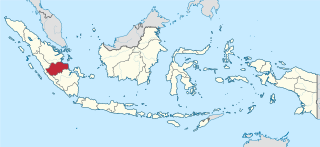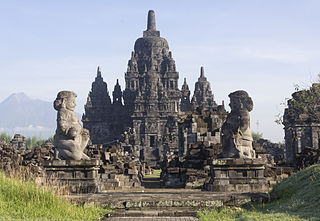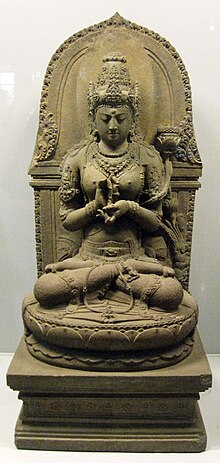
Borobudur, also transcribed Barabudur is a 9th-century Mahayana Buddhist temple in Magelang Regency, near the city of Magelang and the town of Muntilan, in Central Java, Indonesia.

Jambi is a province of Indonesia. It is located on the east coast of central Sumatra and stretches to the Barisan Mountains in the west. Its capital and largest city is also called Jambi. It is bordered by the provinces of Riau to the north, West Sumatra to the west, Bengkulu to the southwest, South Sumatra to the south, and shares a maritime border with the Riau Islands to the east and the Pacific Ocean to the east. The province has a land area of 49,026.58 km2, and a sea area of 3,274.95 km2.It's area is comparable to the European country, Slovakia. It had a population of 3,092,265 according to the 2010 census and 3,548,228 according to the 2020 census; the official estimate of population as of mid-2022 was 3,631,136.

Prambanan is a 9th-century Hindu temple compound in the Special Region of Yogyakarta, in southern Java, Indonesia, dedicated to the Trimūrti, the expression of God as the Creator (Brahma), the Preserver (Vishnu) and the Destroyer (Shiva). The temple compound is located approximately 17 kilometres (11 mi) northeast of the city of Yogyakarta on the boundary between Central Java and Yogyakarta provinces.

Tourism in Indonesia is an important component of the Indonesian economy as well as a significant source of its foreign exchange revenues. Indonesia was ranked at 20th in the world tourist Industry in 2017, also ranked as the ninth-fastest growing tourist sector in the world, the third-fastest growing in Asia and fastest-growing in Southeast Asia. In 2018, Denpasar, Jakarta and Batam are among of 10 cities in the world with fastest growth in tourism, 32.7, 29.2 and 23.3 percent respectively. The tourism sector ranked as the 4th largest among goods and services export sectors.

A Buddhist temple or Buddhist monastery is the place of worship for Buddhists, the followers of Buddhism. They include the structures called vihara, chaitya, stupa, wat and pagoda in different regions and languages. Temples in Buddhism represent the pure land or pure environment of a Buddha. Traditional Buddhist temples are designed to inspire inner and outer peace.

The Mataram Kingdom ; also known as Medang Kingdom was a Javanese Hindu–Buddhist kingdom that flourished between the 8th and 11th centuries. It was based in Central Java, and later in East Java. Established by King Sanjaya, the kingdom was ruled by the Shailendra dynasty and Ishana dynasty.

Buddhism has a long history in Indonesia, and is one of the six recognized religions in Indonesia, along with Islam, Christianity, Hinduism and Confucianism. According to 2022 estimates roughly 0.7% of the total citizens of Indonesia were Buddhists, and numbered around 2 million. Most Buddhists are concentrated in Jakarta, Riau, Riau Islands, Bangka Belitung, North Sumatra, and West Kalimantan. These totals, however, are probably inflated, as practitioners of Taoism and Chinese folk religion, which are not considered official religions of Indonesia, likely declared themselves as Buddhists on the most recent census. Today, the majority of Buddhists in Indonesia are Chinese and other East Asians, however small communities of native Buddhists also exist.

Sleman Regency is an Indonesian regency on the island of Java. It is located in the north of the Yogyakarta Special Administrative Region, Indonesia, and has an area of 574.82 square kilometres (221.94 sq mi), with a population of 1,093,110 at the 2010 Census and 1,125,804 at the 2020 Census; the official estimate as at mid 2022 was 1,147,562 - comprising 569,577 males and 577,985 females. Its capital is the town of Sleman. The current regent is Kustini Sri Purnomo.

A candi is a Hindu or Buddhist temple in Indonesia, mostly built during the Zaman Hindu-Buddha or "Hindu-Buddhist period" between circa the 4th and 15th centuries.

Kedu Plain, also known as Progo River Valley, is the fertile volcanic plain that lies between the volcanoes Mount Sumbing and Mount Sundoro to the west, and Mount Merbabu and Mount Merapi to the east. It roughly corresponds to the present-day Magelang and Temanggung Regency of Central Java, Indonesia.

The National Museum of Indonesia is an archeological, historical, ethnological, and geographical museum located in Jalan Medan Merdeka Barat, Central Jakarta, right on the west side of Merdeka Square. Popularly known as the Elephant Museum after the elephant statue in its forecourt, its broad collections cover all of Indonesia's territory and almost all of its history. The museum has endeavoured to preserve Indonesia's heritage for two centuries.

Candi Plaosan, also known as the Plaosan Complex, is one of the Buddhist temples located in Bugisan village, Prambanan district, Klaten Regency, Central Java, Indonesia, about 1 kilometre to the northeast of the renowned Hindu Prambanan Temple.

Prambanan Temple Compounds is the World Heritage designation of a group of Hindu temple compounds that lie on the border between Yogyakarta and Central Java, Indonesia. It comprises Prambanan, Lumbung, Bubrah and Sewu temple compounds, all are located within Prambanan Archaeological Park.

Borobudur Temple Compounds is the World Heritage designation of the area of three Buddhist temples in Central Java, Indonesia. It comprises Borobudur, Mendut, and Pawon. The temples were built during the Shailendra dynasty around the 8th and 9th centuries CE and fall on a straight line.

Kewu Plain, also known as Prambanan Plain or Opak River Valley, is a fertile volcanic plain that lies between the Merapi-Merbabu complex in the north, the Bantul lowlands and Sewu karst limestone range in the south, Bengawan Solo river valley in the east, the Progo River in the west, and Kedu Plain on the northwest. It is located within the Yogyakarta Special Region, Sleman Regency, Klaten Regency, and Solo City, Indonesia.

Cultural properties of Indonesia are those items defined by Indonesian law as of "important value for history, science, and culture", and include both man-made artefacts and natural objects. The cultural properties number more than 8,000 and include ancient Hindu and Buddhist temples, mosques, historic colonial buildings, forts, art galleries, national parks and beaches. A number of the sites are World Heritage Sites.

It is quite difficult to define Indonesian art, since the country is immensely diverse. The sprawling archipelago nation consists of 17.000 islands. Around 922 of those permanently inhabited, by over 1,300 ethnic groups, which speak more than 700 living languages.

Satyawati Suleiman was an Indonesian historian and archaeologist. She is considered a pioneer in Indonesian archaeology and was one of the first women in the field, being the first female archaeology graduate from her alma mater at the University of Indonesia. Her contributions were particularly noted in archaeological research on Srivijaya.

Sumberawan is a Buddhist stupa located in Toyomarto village, Sumberawan subdistrict, Malang Regency, East Java, Indonesia. The stupa is located in the highlands, on the southern slope of Mount Arjuno, surrounded by numerous Springs.

The National Archaeology Research Institute was an Indonesian research center coordinated under the Agency of Education Standards, Curricula, and Assessments of the Ministry of Education, Culture, Research, and Technology. It was one of the oldest state research institutions in the country, operating since the early 20th century.

























